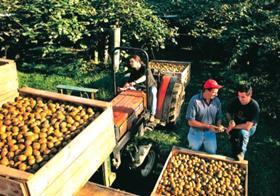
Prices of fruit exported from New Zealand, such as apples and kiwifruit, are set to rise considerably this year thanks to strong market demand, according to a report from the country's Ministry Agriculture and Forestry (MAF).
The Horticulture and Arable Monitoring Report 2008 shows thatdespite increasing costs many growers in the horticulture and arablesectors had an improved financial outcome for the 2008 harvest season.
Lower global supplies, due to unfavourable weather conditions andother factors, resulted in higher prices for apples, blackcurrants,lemons, cereal grains, and honey. High yields and increased producingareas for avocados, meanwhile, delivered recordproduction levels for these crops in 2008.
Paul Stocks, deputy director of general policy at MAF, said growers have responded well to the challenges.
'Last season was challenging for New Zealand growers with risingexpenses and the continued strength of the New Zealand dollar. Despitethese factors, many sectors have demonstrated their resilience andability to respond flexibly to market conditions,' said Mr Stocks.
For topfruit, the ministry revealed that demand is strong in overseas markets, influenced by frost-hit export crops in New Zealand and other Southern Hemisphere countries.
'Growers are confident market prices will improve, forecasting an average return of NZ$22.40 or more per carton,' the report said. 'The ministry's model Nelson orchard expects a big rise in profit, while forecast profits for the model Hawke's Bay orchard will limit the scale of redevelopment into new varieties and intensive plantings without much new debt.'
For kiwifruit, prices are expected to improve thanks to favourable opening market conditions in Europe, good size and quality, an early start to the season and a falling exchange rate. 'The model orchard is expected to make a small profit,' the ministry confirmed.
While the majority of the country's fruit growers had an improvedoutcome, the report shows growers of most vegetable crops experienced apoorer financial outcome due to increasing costs that could not bematched by greater yields or prices.
'Despite the improvement in financial performance for the 2008season, the short-term profitability of some crop sectors remainschallenged, with businesses struggling to generate adequate funds forreinvestment. Growers on small-scale properties in particular are moreand more reliant on off-farm income and investments,' said Mr Stocks.
The report finds that growers expect further cost increases in theyear ahead, and are seeking to manage this by maximising income throughimproved yields and quality and by the more efficient use of inputs.
'While considerable challenges face the sectors, there are also manyopportunities. World demand for food products with assurances of safetyand environmental sustainability is increasing, and the decline inworld cereal stocks and the expansion of the dairy sector in NewZealand are providing growers of vegetable and arable crops, inparticular, with opportunities to increase income,' Mr Stocks said.
The Horticulture and Arable Monitoring Report is compiled byMAF annually and provides an overview of the economic performance oforchards, vineyards and arable farms throughout New Zealand for theannual growing season. Forecasts for the 2008 season in the report arebased on growers’ views collected in May this year.
A fact sheet on the Horticulture and Arable Monitoring Report 2008 is available here. Copies of the report are available on the MAF website.



